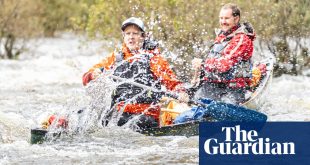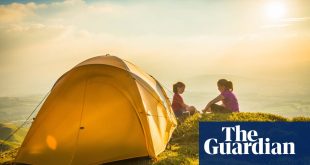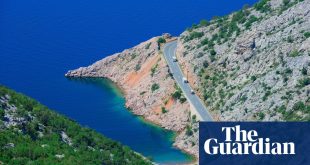I was eating homemade crostata (jam tart) on a roof terrace in the Sicilian town of Cefalù and reading about Helius, the ancient Greek god of the sun. Sicily is supposedly the inspiration for the deity’s island in The Odyssey and this makes perfect sense – with more than 300 days of sunshine a year, Helius would like it here. The island is especially lovely in spring, when it’s quieter, cooler and more peaceful than in the scorching summer.
Cefalù is an ancient fishing village almost exactly halfway along Sicily’s north coast. It’s prized by Italians as one of the island’s loveliest beach-side places. Barbara De Gaetani, a licensed tour guide who grew up here, told me the allure of the place is difficult to explain: “Many other places are gorgeous but not as seductive. You can feel life flowing here, and it’s no accident that many film-makers have used the town as a location.”
Compared with Sicily’s ritzier spots, to me it feels more authentic and has a sort of relaxed old-school glamour. It’s also easy to reach by train from Palermo (about 50 minutes); from Catania, on the other side of the island, it takes around four hours, including a change in Messina.
The place is full of extraordinary Arab Norman architecture and, as with most Italian towns, I found there were almost too many beautiful buildings and churches to take in as I wandered slowly through the streets towards the cathedral in the central square. Inside, famed 12th-century Byzantine golden mosaics cover the domed ceiling. Up close they are even more extraordinary than they look in the pictures, and still shine brightly all these years later.
I spent long moments looking up at radiant Christ Pantocrator (the Almighty) as he gazed down serenely, his fingers held up in a complicated arrangement that signifies “Jesus Christ”. According to legend, King Ruggero Secondo (Roger II) built the duomo after being saved from a terrible storm at sea. He’d knelt on the deck of his ship and prayed for help, promising to erect a cathedral to God’s glory if he made it back alive. After washing up safe and sound on the beach of Cefalù he set about keeping his end of the bargain.
After all that divinity, I continued through the maze of streets in search of something more prosaic, the lavatoio medievale, a washhouse built in 1514. Steps down from the street led to a series of low troughs, each with a stone scrubbing surface at one end. River water flows through bronze lion heads to fill the troughs before heading out to sea, and the place was still used well into the 20th century. I walked around the troughs getting my feet wet, imagining the washerwomen of the past, and feeling grateful for washing machines. A short walk away is the picturesque Porta Pescara gate, which frames the beach beautifully.
Behind the town is a steep cliff called the Rocca di Cefalù. The path was closed for maintenance when I was here but it’s open again now and a brisk 45-minute uphill climb offers panoramic vistas over the town and surrounding coast. There’s a ninth-century Temple of Diana on the way up (wear decent footwear as the path can be slippery).
One of the things I like most about Cefalù is that the beach is just a couple of minutes’ walk from the old town. And unusually for Sicily, it’s a generous crescent of soft golden sand, rather than a standard rocky beach. Perfect for bambini, it’s one of the reasons the town is so popular with Italian tourists. In spring you’ll need a jumper and light jacket as you walk along the promenade, and while the sea remains chilly, as a cold-water swimming addict, I enjoyed the blast of endorphins when I plunged beneath the waves.
Another day I walked 30 minutes east along the coast road to swim at Cala Kalura, a sweet pebbly cove with swimming-pool ladders down into the sea. If you get lucky, like I did, you might see a pair of kingfishers hunting for fish as the dusk falls.
The Cefalù food scene can be a little touristy but there are some lovely places. My favourite was La Brace, where the service is friendly and the menu includes traditional swordfish rolls and other delights. At the far fancier Triscele, I ate beautifully presented gamberi crudi (raw prawns) served in a swirl of citrus risotto on the romantic terrace.
Some of the best ice-cream in town can be found at L’Angolo delle Dolcezze along with cannoli, the dangerously addictive cigar-shaped sweet pastries filled with ricotta. Cassata, a cake layered with ricotta and covered in violently green icing, is a traditional treat, but for me nothing beats cartocci, doughnut spirals, again filled with the ubiquitous ricotta or, even better, with custard. Bar Duomo on the Cathedral Square is a great spot to enjoy one with a coffee and some relaxed people watching by day.
after newsletter promotion
At night, it’s the place for an Aperol spritz before dinner; I also enjoyed an aperitif of Castellucci Miano, an award-winning straw-coloured white wine, on the sea-view terrace of Le Petit Tonneau.
I stayed at Agrodolce B&B (doubles from €75, two-night minimum), where the rooms are simple, the location perfect and the breakfast heavenly. Rita, the owner, radiated Sicilian warmth as she served me homemade crostata along with croissants, fruit and espresso, and encouraged me to have seconds of everything. There are plenty of other mid-range options in town, but for a splurge, Le Calette (doubles from €323 B&B), on the coast east of town, offers luxury suites and stunning views.
On Rita’s recommendation, I caught the 7.45am bus from the station, winding up mountain roads towards Castelbuono, a small town famed for its funghi di bosco, mushrooms foraged from the forests. It was a vertiginous route and I was very glad not to be driving. Rita had suggested – insisted actually – that I come here to visit the Palatine Chapel inside Ventimiglia castle. Built in the late 17th century, it contains the skull of Saint Anne, mother of the Virgin Mary, and is gloriously overdecorated: bright gold walls are covered in maximalist stucco depictions of allegories and religious figures in baroque style. I spent a long time looking around, feeling dizzy and uplifted all at once.
I’d read that there were hidden paintings inside the Matrice Vecchia church on Castelbuono’s main square, but I couldn’t find the light switch and the dark steps down under the altar looked forbidding. Eventually I gave up waiting for the priest and ventured down using my phone torch.
The crypt is covered with frescoes dating from the medieval ages to the Renaissance – including some alarming depictions of skeletons enthusiastically climbing out of their coffins on Judgment Day. I was glad to resurface into the sunlight, and spent a while sitting watching the donkeys walk up and down the narrow streets. They’re used as rubbish collectors because the lanes are too narrow for dustbin lorries, and looked pretty grumpy about it.
I stopped for lunch at Ristorante Nangalarruni where the charismatic owner, Giuseppe, and I argued about mushrooms. I don’t like them at all but he was adamant that if I tasted his pasta I would completely change my mind. We made a deal. He brought me spaghetti cacio, pepe e funghi di bosco and watched anxiously as I twirled my fork and took a bite. He was right: the dish changed a lifetime of bias, and remains one of the best meals I’ve eaten in Sicily. Later I caught the bus back to Cefalù and took a long siesta to sleep off all those carbs – another perfect day on Helius’s sunshine island.
Laura Coffey’s book, Enchanted Islands: Travels through Myth & Magic, Love & Loss (Summersdale, £16.99), is published on 2 May. To support the Guardian and Observer, order your copy at guardianbookshop.com. Delivery charges may apply
 Top Naija News: Nigerian News, Breaking News Nigeria and World News Top Naija News is a daily news publication in Nigeria, delivering the latest breaking news in Nigeria and around the world.
Top Naija News: Nigerian News, Breaking News Nigeria and World News Top Naija News is a daily news publication in Nigeria, delivering the latest breaking news in Nigeria and around the world.



